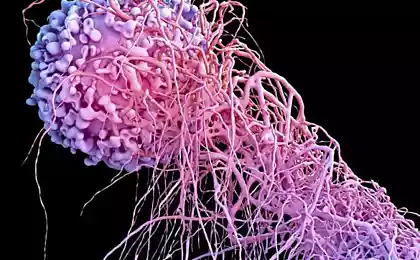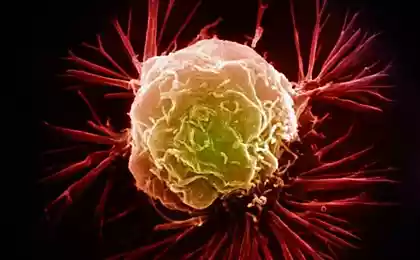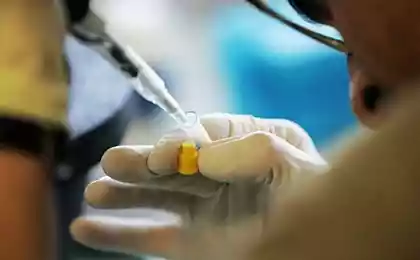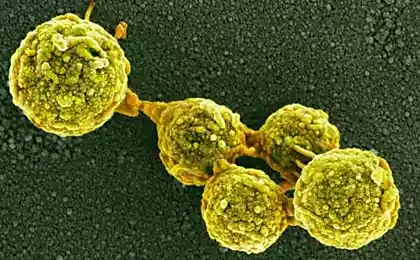557
Aging is not an inevitable fact — the secrets to a long life
Aging is not an inevitable fact of life — many animals have found a way to delay the moment of death. Their tips can help us all to enjoy a long and healthy life. For example, at least two hundred years. You can imagine that? I Yes.
Just 30 years after the publication of "Moby dick", a group of Alaskan whalers tried to curb their own giant out of the ocean. Their goal was the bowhead whale, a male, the second largest mammal on Earth. This species is famous for its amazing durability: according to the folk of the Inuit, these whales live "two lives," and are released from the harpoons due to his enormous strength.

These whalers were armed with the latest technology, in particular — "a spear-bomb" that explodes on impact to penetrate a thick layer of whale oil. However, this was not enough to defeat the whale. Three fragments of a spear hit him in the side, but he broke free and walked away with only superficial wounds.
Keith continued to wander not caught another 120 years, until 2007, until a group of whalers he was finally caught. She even found fragments of the spears which had remained in the whale fat.
For a variety of estimates, these whales live at least 150 years and possibly up to 210 years. Other than the slightly wrinkled skin, excess fat and battle scars, whales show surprisingly little of the harmful effects of long life. That, in turn, is of great interest to doctors who study aging.
"They live much longer than humans, but they live in the wild, not going to the doctor and not taking advantage of the benefits of human society, "says Joao Pedro de Magalhaes. from the University of Liverpool. — Thus, they should be naturally protected from the diseases of old age".
Associated with aging a variety of factors.
First, the environment: no one can live in a bubble, so our DNA and other molecular engineering is slowly damaged by harmful chemicals or radiation. Although our cells have repair tools, in the end, the destruction is too extensive, lead to mutations, and the cells grow into a tumor.
We could also solve the problem with own metabolism: as a furnace in need of regular cleaning, our cells generate a lot of waste as combustion energy. Waste accumulate over time and can disrupt important biological processes. "The amount of damage accumulates and the body is unable to deal with it," — said Gladyshev.
Finally, the body faced with the challenges of organ regeneration: each chromosome has a bunch of DNA at the ends called telomeres which behave like the plastic tips on shoelaces, preventing their spread. The telomere gets shorter every time the cell divides until eventually becomes so short that the cell starts to function properly or dies. With this outcome we become vulnerable to various diseases.
Everything points to the fact that some irresistible force pushing us to death — but multiple lines of evidence suggests that there are brakes that can slow the process. For example, a common diabetic drug, Metformin, may be a bit slow aging in mice. And a simple change of one gene involved in the cellular metabolism in annelids, can do much to prolong his life; and although it is unlikely that such changes will help to more complex organisms, all of this suggests that aging is quite manageable. "Aging is surprisingly plastic process that can be controlled," says de Magalhaes..
Scientists like Magalhaes. Gladysheva and are in search of other candidates, using as leaders real Methuselah (Methuselah — the longest-lived biblical character). Alone among mammals, the duration of life there is very different from the shrews that live no longer than six months to bowhead whales, which live more than two hundred years. For some reason, natural selection has pushed certain beings to develop their own elixirs of life.
"Metformin is a little prolongs life of mice, but if you look at things, the ability of natural selection to increase the duration of life is much more powerful," says de Magalhaes.. They will be more likely to develop other mechanisms of renewal of life, resisting cancer and other age-related diseases". Or as noted by Gladyshev, "nature changes the life expectancy of the time, the only question is how she does it. Can we focus on the mechanics, thereby extending the lifespan of people?
The most interesting creatures are among the special centenarians; a particular species can survive, it seems, even the next of kin. And they are not always so majestic as the bowhead whale. With his wrinkled and hairless skin, naked mole rat does not look like a child on a poster promoting a healthy lifestyle — but living up to 30 years, much more than 2-3 years, who can afford a conventional mouse. In addition, the naked mole rat is extremely resistant to cancer — thousands of individual diggers, studied in labs, there has never been a single case of cancer. Even when they are bathed in strong carcinogens, they remained invulnerable to cancer.
This may be partly explained by the fact that their cells cease to grow when they become too dense — this mechanism stops the reproduction of the tumor and takes growth under control. And he, it seems, stems from a particularly "heavy" version of a chemical known as hyaluronic acid. This molecule is part of the scaffolding surrounding the cage, and could initially participate in the development of the elasticity of the skin of naked mole rat, so it is easier to squeeze through tight holes. Today, it seems, is part of the signaling system, which stops the cells from uncontrolled reproduction. In other words, even if a mutation allows tumors to form, hyaluronic acid is stop its further development.
Gladyshev studied bat Brandt's — the little creature that lives for over 40 years, despite the fact that it weighs a little more than a cube of sugar. "Considering its size, this case the most extreme," says Gladyshev. He found unusual mutations around the receptor mice, which are aboutbespechivaet growth hormone and insulin-like growth factor — changes that might help us think about how to monitor metabolism in animals, limiting the damage that usually come with age.

The immortal zoo
Can some beings live forever?
The bowhead whale can live for more than two centuries, making it the oldest mammal. But how can you compare it with other types of organisms? Research on the seeds of the bristlecone pine, which lives up to 4700 years old, showed no specific cellular mutations that could occur over time.
Colonial animals like corals can live for more than 4000 years. But some polyps do not last more than a few years.
The Ming clam is the oldest single animal. This oceanic survivor was 507 years oldwhen the biologists got it from coastal waters near Iceland in 2006.
If you start from the human rate of development of cancer, all large whales must be riddled with tumors before birth — but they continue to live and live. This fact is known as the "paradox of Peta and evidence that whales, like naked mole rats, have in the sleeve evolutionary cunning tricks to cope with harmful mutations. If you put them in the context of other animals, they really are centenarians. They must have some mechanisms to suppress growth of tumors, which we do not have.
It is these mechanisms, and more, trying to find Magalhaes. peering into the genome of the whale. Initially, he tried to experiment with fabric. And eventually found a team that has established relationships with Inuit hunters. To maintain their living traditions, indigenous companies in and around the Arctic catch and kill a limited number of bowhead whales each year. Although initially they were suspicious of outsiders, in the end, the hunters agreed to help scientists take some tissue from the prey.
The result was a series of insights, which could pave the way for future medicine. Special interest scientists saw changes in the gene, called ERCC1. This gene is known to encode molecular tools that can patch small areas of damaged genome. It seems that one mutation of bowhead whales went further and, perhaps, prevents the accumulation of harmful mutations that cause cancer.
The researchers also found changes in the gene for PCNA, which is involved in cell proliferation. It encodes a protein that acts as a kind of clip that connects the molecular machines that cause DNA replication. Bowhead whales have double the sites with the gene, and mutations seem to help to interact with other parts of the tool involved in the repair of DNA. Scientists have suggested that this is one of the changes may provoke the growth of cells without damage that come with age. Considering other important adaptation, it may help the whales to reduce cellular stress, which in turn can lead to a long life of mammals.

A sign of longevity
On the other side of the Atlantic, at Harvard, Gladyshev has recently undertaken its own study of the "transcriptome" of bowhead whales; not only by studying the genes, but also by examining their activity. If you see that some genes are particularly active, you know they can also play an important role in aging. Scientists have discovered the same types of changes in the signaling system of insulin, which noticed off the bat Brandt. "Perhaps it changes the metabolic configuration of cells, somehow they become long-lived. However, these findings require careful analysis". The results lead to "the basis of longevity", according to the scientist, and thus can be used in further studies.
At this threshold, we can detect a lot of possible ways to improve our treatment. Gladyshev contends that we could see if some diet or exercise to help our bodies produce life expectancy similar to that of a whale. For example, some claim that fasting, or restriction of calories slows the aging process, and it would be interesting to compare metabolic changes, whether they resemble those that allow whales to live so long. In this sense, bowhead whales could become our guides to a long, happy life.
In addition, these long-lived creatures could inspire us to more radical methods of treatment. The first step, says de Magalhaes., to grow human tissue with mutations that have been found in bowhead whales, bat Brandt and naked mole rat. "If we change human proteins so that they resembled animals, we can see changes in DNA," he says. And I'd like to take the genes of the bowhead whale and put them in mice to see whether they will live longer."
Obviously, all the hard work ahead...
De Magalhaes. and Gladyshev have no illusions about the difficulty of the path but don't lose hope. "History is full of experts who considered certain things impossible and in the end turned out to be wrong," says de Magalhaes....
Ultimately, de Magalhaes. believes aging is the ultimate disease — disease that can be cured by itself. "We just extended the time decay," he says. — We want 70-year-old was healthy 50-year — old- this was the goal. Maybe in the year 2120, we will look at the past, wondering the first steps to achieving this goal. published
P. S. And remember, only by changing their consumption — together we change the world! ©
Join us in Facebook , Vkontakte, Odnoklassniki
Source: vk.com/probujdeniechelovechnost?w=wall-66683693_6082%2Fall
Just 30 years after the publication of "Moby dick", a group of Alaskan whalers tried to curb their own giant out of the ocean. Their goal was the bowhead whale, a male, the second largest mammal on Earth. This species is famous for its amazing durability: according to the folk of the Inuit, these whales live "two lives," and are released from the harpoons due to his enormous strength.

These whalers were armed with the latest technology, in particular — "a spear-bomb" that explodes on impact to penetrate a thick layer of whale oil. However, this was not enough to defeat the whale. Three fragments of a spear hit him in the side, but he broke free and walked away with only superficial wounds.
Keith continued to wander not caught another 120 years, until 2007, until a group of whalers he was finally caught. She even found fragments of the spears which had remained in the whale fat.
For a variety of estimates, these whales live at least 150 years and possibly up to 210 years. Other than the slightly wrinkled skin, excess fat and battle scars, whales show surprisingly little of the harmful effects of long life. That, in turn, is of great interest to doctors who study aging.
"They live much longer than humans, but they live in the wild, not going to the doctor and not taking advantage of the benefits of human society, "says Joao Pedro de Magalhaes. from the University of Liverpool. — Thus, they should be naturally protected from the diseases of old age".
Associated with aging a variety of factors.
First, the environment: no one can live in a bubble, so our DNA and other molecular engineering is slowly damaged by harmful chemicals or radiation. Although our cells have repair tools, in the end, the destruction is too extensive, lead to mutations, and the cells grow into a tumor.
We could also solve the problem with own metabolism: as a furnace in need of regular cleaning, our cells generate a lot of waste as combustion energy. Waste accumulate over time and can disrupt important biological processes. "The amount of damage accumulates and the body is unable to deal with it," — said Gladyshev.
Finally, the body faced with the challenges of organ regeneration: each chromosome has a bunch of DNA at the ends called telomeres which behave like the plastic tips on shoelaces, preventing their spread. The telomere gets shorter every time the cell divides until eventually becomes so short that the cell starts to function properly or dies. With this outcome we become vulnerable to various diseases.
Everything points to the fact that some irresistible force pushing us to death — but multiple lines of evidence suggests that there are brakes that can slow the process. For example, a common diabetic drug, Metformin, may be a bit slow aging in mice. And a simple change of one gene involved in the cellular metabolism in annelids, can do much to prolong his life; and although it is unlikely that such changes will help to more complex organisms, all of this suggests that aging is quite manageable. "Aging is surprisingly plastic process that can be controlled," says de Magalhaes..
Scientists like Magalhaes. Gladysheva and are in search of other candidates, using as leaders real Methuselah (Methuselah — the longest-lived biblical character). Alone among mammals, the duration of life there is very different from the shrews that live no longer than six months to bowhead whales, which live more than two hundred years. For some reason, natural selection has pushed certain beings to develop their own elixirs of life.
"Metformin is a little prolongs life of mice, but if you look at things, the ability of natural selection to increase the duration of life is much more powerful," says de Magalhaes.. They will be more likely to develop other mechanisms of renewal of life, resisting cancer and other age-related diseases". Or as noted by Gladyshev, "nature changes the life expectancy of the time, the only question is how she does it. Can we focus on the mechanics, thereby extending the lifespan of people?
The most interesting creatures are among the special centenarians; a particular species can survive, it seems, even the next of kin. And they are not always so majestic as the bowhead whale. With his wrinkled and hairless skin, naked mole rat does not look like a child on a poster promoting a healthy lifestyle — but living up to 30 years, much more than 2-3 years, who can afford a conventional mouse. In addition, the naked mole rat is extremely resistant to cancer — thousands of individual diggers, studied in labs, there has never been a single case of cancer. Even when they are bathed in strong carcinogens, they remained invulnerable to cancer.
This may be partly explained by the fact that their cells cease to grow when they become too dense — this mechanism stops the reproduction of the tumor and takes growth under control. And he, it seems, stems from a particularly "heavy" version of a chemical known as hyaluronic acid. This molecule is part of the scaffolding surrounding the cage, and could initially participate in the development of the elasticity of the skin of naked mole rat, so it is easier to squeeze through tight holes. Today, it seems, is part of the signaling system, which stops the cells from uncontrolled reproduction. In other words, even if a mutation allows tumors to form, hyaluronic acid is stop its further development.
Gladyshev studied bat Brandt's — the little creature that lives for over 40 years, despite the fact that it weighs a little more than a cube of sugar. "Considering its size, this case the most extreme," says Gladyshev. He found unusual mutations around the receptor mice, which are aboutbespechivaet growth hormone and insulin-like growth factor — changes that might help us think about how to monitor metabolism in animals, limiting the damage that usually come with age.

The immortal zoo
Can some beings live forever?
The bowhead whale can live for more than two centuries, making it the oldest mammal. But how can you compare it with other types of organisms? Research on the seeds of the bristlecone pine, which lives up to 4700 years old, showed no specific cellular mutations that could occur over time.
Colonial animals like corals can live for more than 4000 years. But some polyps do not last more than a few years.
The Ming clam is the oldest single animal. This oceanic survivor was 507 years oldwhen the biologists got it from coastal waters near Iceland in 2006.
If you start from the human rate of development of cancer, all large whales must be riddled with tumors before birth — but they continue to live and live. This fact is known as the "paradox of Peta and evidence that whales, like naked mole rats, have in the sleeve evolutionary cunning tricks to cope with harmful mutations. If you put them in the context of other animals, they really are centenarians. They must have some mechanisms to suppress growth of tumors, which we do not have.
It is these mechanisms, and more, trying to find Magalhaes. peering into the genome of the whale. Initially, he tried to experiment with fabric. And eventually found a team that has established relationships with Inuit hunters. To maintain their living traditions, indigenous companies in and around the Arctic catch and kill a limited number of bowhead whales each year. Although initially they were suspicious of outsiders, in the end, the hunters agreed to help scientists take some tissue from the prey.
The result was a series of insights, which could pave the way for future medicine. Special interest scientists saw changes in the gene, called ERCC1. This gene is known to encode molecular tools that can patch small areas of damaged genome. It seems that one mutation of bowhead whales went further and, perhaps, prevents the accumulation of harmful mutations that cause cancer.
The researchers also found changes in the gene for PCNA, which is involved in cell proliferation. It encodes a protein that acts as a kind of clip that connects the molecular machines that cause DNA replication. Bowhead whales have double the sites with the gene, and mutations seem to help to interact with other parts of the tool involved in the repair of DNA. Scientists have suggested that this is one of the changes may provoke the growth of cells without damage that come with age. Considering other important adaptation, it may help the whales to reduce cellular stress, which in turn can lead to a long life of mammals.

A sign of longevity
On the other side of the Atlantic, at Harvard, Gladyshev has recently undertaken its own study of the "transcriptome" of bowhead whales; not only by studying the genes, but also by examining their activity. If you see that some genes are particularly active, you know they can also play an important role in aging. Scientists have discovered the same types of changes in the signaling system of insulin, which noticed off the bat Brandt. "Perhaps it changes the metabolic configuration of cells, somehow they become long-lived. However, these findings require careful analysis". The results lead to "the basis of longevity", according to the scientist, and thus can be used in further studies.
At this threshold, we can detect a lot of possible ways to improve our treatment. Gladyshev contends that we could see if some diet or exercise to help our bodies produce life expectancy similar to that of a whale. For example, some claim that fasting, or restriction of calories slows the aging process, and it would be interesting to compare metabolic changes, whether they resemble those that allow whales to live so long. In this sense, bowhead whales could become our guides to a long, happy life.
In addition, these long-lived creatures could inspire us to more radical methods of treatment. The first step, says de Magalhaes., to grow human tissue with mutations that have been found in bowhead whales, bat Brandt and naked mole rat. "If we change human proteins so that they resembled animals, we can see changes in DNA," he says. And I'd like to take the genes of the bowhead whale and put them in mice to see whether they will live longer."
Obviously, all the hard work ahead...
De Magalhaes. and Gladyshev have no illusions about the difficulty of the path but don't lose hope. "History is full of experts who considered certain things impossible and in the end turned out to be wrong," says de Magalhaes....
Ultimately, de Magalhaes. believes aging is the ultimate disease — disease that can be cured by itself. "We just extended the time decay," he says. — We want 70-year-old was healthy 50-year — old- this was the goal. Maybe in the year 2120, we will look at the past, wondering the first steps to achieving this goal. published
P. S. And remember, only by changing their consumption — together we change the world! ©
Join us in Facebook , Vkontakte, Odnoklassniki
Source: vk.com/probujdeniechelovechnost?w=wall-66683693_6082%2Fall
How to quickly and easily recover after giving birth
Serial electric supercar Concept One will be shown at the Geneva motor show























